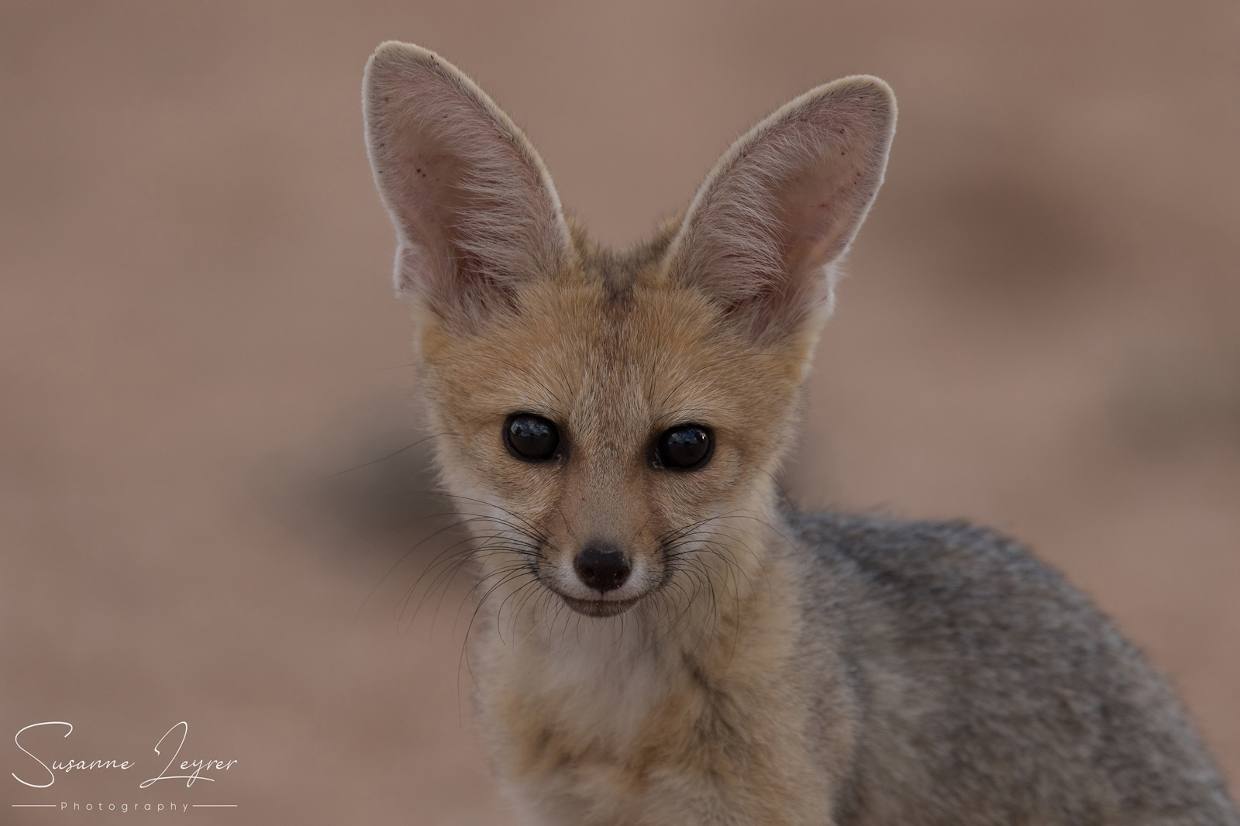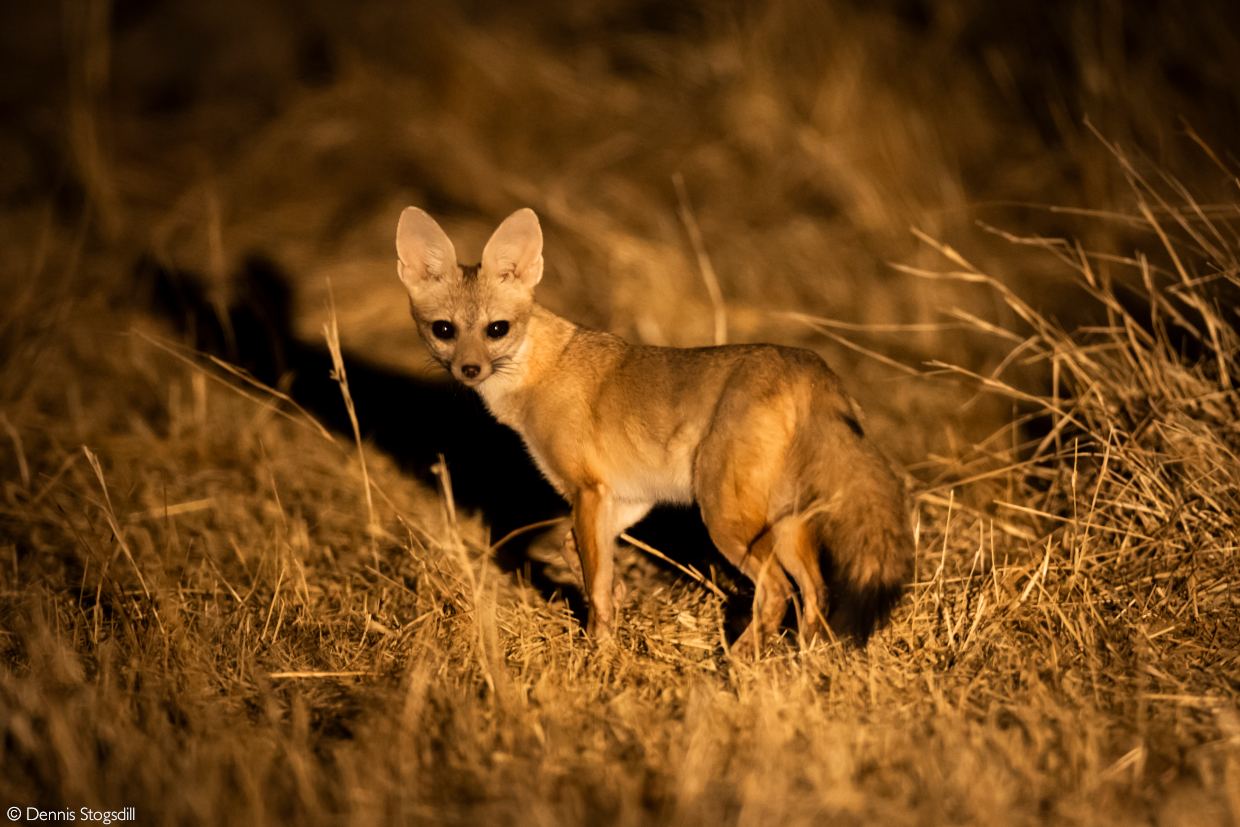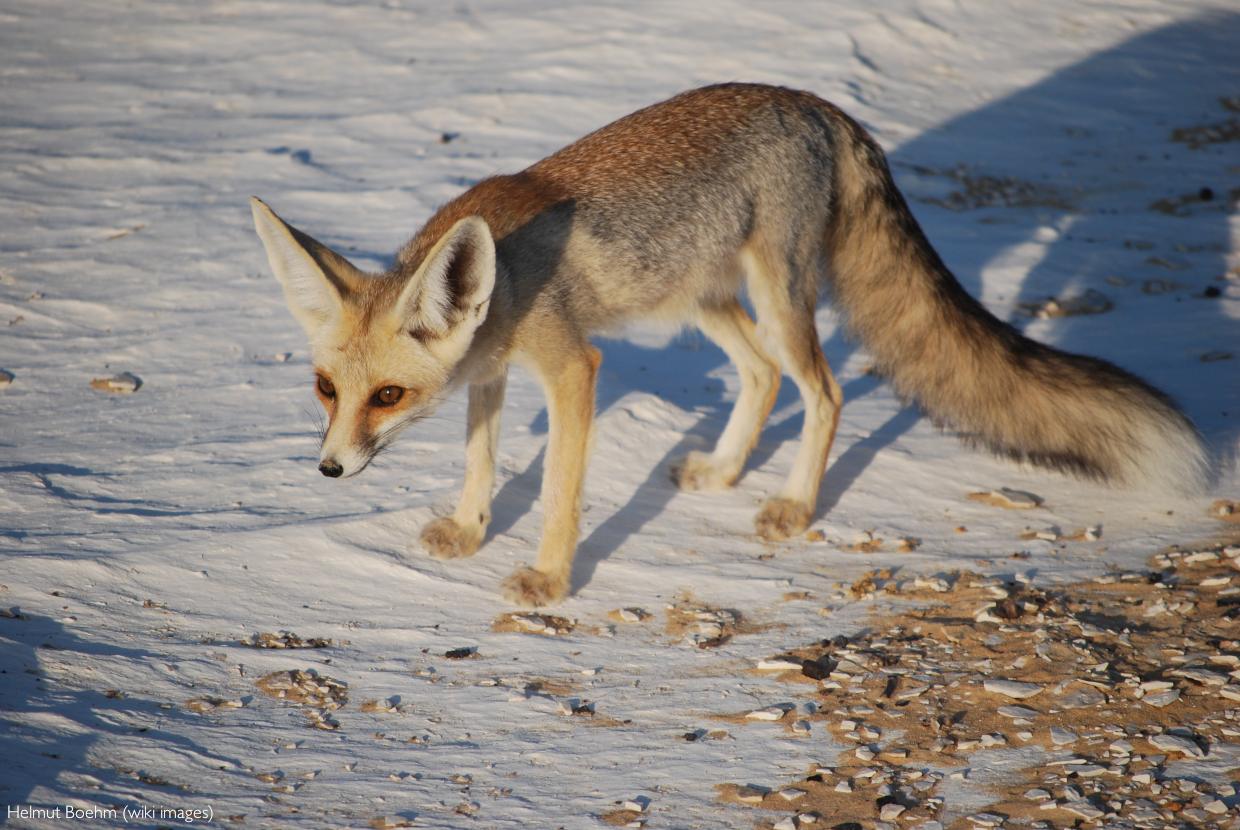Today, 11 African canids, from excitable African painted wolves and shrewd jackals to the tiny fox species, hunt the continent’s desert, alpine grassland, savanna and woodland.
Some 40 million years ago, the first identifiable canid (dog) species, Prohesperocyon wilsoni, arose in what is now Texas. The fossilised remains were classified as Canid partially because of the absent, upper third molars and an enlarged bulla (a hollow structure in the ear). As canids diversified across North America, evolution favoured them with several cursorial adaptations including long limbs and lightweight bodies. They were built to run from the start – a family trait that served them well and has survived in most species. When cooling climates exposed the Bering land bridge, canid ancestors raced, trotted, and slunk across to spread through Asia, Europe and eventually Africa.

African painted wolf (Lycaon pictus)
The most well-known African canid, African painted wolves (wild dogs), are the third-largest extant canid in the world and the largest in Africa. They are coursing, cooperative hunters, with lithe, athletic bodies built for speed and stamina. Their frenetic hunting style exploits panic and confusion, creating fast-paced, exhilarating sightings for those fortunate enough to encounter a pack on the move.
African painted wolves live in tight-knit packs, and there is little so heart-warming as watching pack members affectionately reaffirming their bonds. In social situations, the intimate relationships are expressed in joyful greeting ceremonies and play sessions, accompanied by an endearing array of squeaks, yips and whines. The alpha pair typically monopolises breeding, while the rest of the pack devote their attentions to feeding and caring for both the mother and her pups during the denning period.
They are the only member of the Lycaon genus and the only canid to have four toes on the front foot (they lack a dewclaw). Human persecution, habitat loss and fragmentation, and disease have all played a role in devastating African painted wolf populations. They are currently listed as “Endangered” on the IUCN Red List. Further reading: What’s in a name?

Black-backed and side-striped jackals (Canis mesomelas and Canis adustus)
It is bewildering that the average safari-goer dismisses jackals, intent rather on chasing down traditionally iconic creatures. This is unfortunate because jackals are attractive and adventurous little predators in their own right. Both species are consummate survivors with an indiscriminate palate and a boldness that belies their slender physiques. Jackals are opportunistic omnivores that can quickly and efficiently dispatch invertebrates, birds, reptiles, or even small antelope, but will also readily wolf down fallen fruit or seeds. Furthermore, any animal that dares to snatch the scraps out from beneath a hungry lion’s nose should be entitled to automatic respect.
Jackals are monogamous and territorial, though they may gather in larger numbers when there is a more substantial carcass. Grown offspring from the previous year’s litter occasionally stay and help their parents with subsequent pups – before dispersing. Interestingly, though the black-backed jackal is the smaller of the two, where black-backed and side-striped jackals do occur in the same place, the black-backed tends to dominate interactions.
African golden wolf (Canis lupaster)
The African golden wolf is notable mainly for the insights it has provided researchers of African canid evolution. Until recently, it was classified as an African variant of the golden jackal, which is widespread throughout the Middle East and Asia. Though scientists had long argued for a distinction between the two species, it was only in 2015 that a series of genetic studies revealed that the golden wolf is more closely related to grey wolves, Ethiopian wolves, and coyotes than it is to Asian golden jackals.
Slightly larger than the two jackal species, African golden wolves can catch and kill prey nearly three times their own mass. This is unusual however, and golden wolves tend to confine themselves to smaller prey species such as rodents, birds, lizards, snakes, and insects.
The wolf-like ancient Egyptian deities such as Anubis (the god of death) may have been based on African golden wolves.

Ethiopian wolf (Canis simensis)
The Ethiopian wolf has the lamentable honour of being the most endangered carnivore in Africa. Fewer than 500 individuals remain, though this is an optimistic estimate. An IUCN estimate made in 2011 suggested a declining population of just 197 mature individuals.
They are endemic to the Ethiopian Highlands and found at altitudes over 3,000m above sea level, with more than half found in the Bale Mountains. The remaining five populations are isolated and fragmented; threatened by habitat degradation, conflict with humans and diseases carried by feral domestic dogs.
While most canid species are fairly generalist feeders, these beautiful, russet-coated Simien wolves are particularly adept at hunting Afroalpine rodents, especially big-headed mole-rats. The wolves wait patiently until a rodent emerges from its underground burrow before pouncing and digging frantically at the entrance. Interestingly, some wolves form temporary associations with geladas, and research indicates that their hunting efforts are more successful when they associate with these foraging troops. The wolves do not attempt to hunt the geladas, and the primates appear unconcerned by the canids’ presence.
While Ethiopian wolves tend to be solitary hunters, they live in small packs with an established hierarchy and one breeding female, who, when she dies, is usually replaced by one of her daughters.

Bat-eared fox (Otocyon megalotis)
These little canids are the only insectivorous canid species in the world and, despite their common name, are not true foxes (genus Vulpes). Instead, they are the only Otocyon member, set apart by their unusual dentition adapted for demolishing invertebrates. They have up to 50 teeth (most canids have around 42), with reduced shearing surfaces on the molars and unique morphological adaptations which allow for extremely rapid chewing. The majority of their prey consists of harvester termites.
Bat-eared foxes are highly social and live in mated pairs or small family groups that forage, play and rest together. Somewhat unusually, the males take on the majority of caretaking activities where the young are concerned.
They are easily identified by their enormous ears (second only to the fennec fox below), and their scientific name refers specifically to this characteristic: “mega” meaning large and “otus” meaning ear.


Cape fox (Vulpes chama)
The only true fox species in sub-Saharan Africa, the delicate Cape fox prefers semi-arid and arid habitats. In true fox fashion, they are omnivores with a taste for everything from small mammals to seeds and fruit. Though common throughout most of Southern Africa, Cape foxes are nocturnal and seldom seen except in certain reserves where they have become habituated to people.
Though they appear to form monogamous bonds, Cape foxes prefer to forage alone, and the male and female usually only associate during the breeding season. When the kits are born in underground burrows, the male will care for and defend both the mother and young for the first few weeks.

Fennec fox (Vulpes zerda)
The fennec fox is the smallest canid species on the planet, weighing less than 2kg. They are perfectly adapted for the aridity and blistering temperatures of their Sahara Desert habitat. Most noticeably, their enormous ears, proportionately the largest of any canid species in the world, help dissipate heat – not unlike the ears of an elephant. Their tiny paws are covered in dense fur to protect against extreme heat and maintain traction on the desert sands. Fennec foxes’ most astonishing achievement is the ability to pant at 690 breaths per minute (over ten breaths per second!) without the expected adverse effects of hyperventilation.
They forage for insects, reptiles, small mammals and birds at night. Plants supplement the diet and aid with hydration.
The fennec fox’s Disney-like appearance has made it a popular exotic pet, even though it is ill-suited to a domestic existence away from its natural desert habitat. Though they are highly social, little is known about the intricacies of their societies, and most behavioural observations have been gleaned from captive individuals.

Pale fox (Vulpes pallida)
Pale foxes are the least studied of all African canids, and little is known about their day-to-day lives or individual numbers. They inhabit the Sahel region of the African continent (the transition zone between the Sahara Desert and savannahs further south). They are distinguished from the Rüppell’s fox (see below) by the black tip on their tails. Just a fraction smaller than the Cape fox, pale foxes are omnivorous and predominantly nocturnal.

Rüppell’s fox (Vulpes ruepelli)
The Rüppell’s fox is confined to the continent’s northernmost reaches and is distinguished by a white-tipped tail and black markings under the eye. Like all desert-dwelling foxes, they have enormous ears, though not quite to the same degree as the fennec fox. Though the species is widely distributed, there is little available information on Rüppell’s foxes.

Red fox (Vulpes vulpes)
Typically associated with the countryside and alleys of European cities, few people realise that red foxes also occur in Africa’s northern fringes. This species is largest of the true foxes, though the southern grey desert subspecies is significantly smaller and less brightly coloured than its European counterparts. These animals are not as well adapted to truly arid areas as other desert foxes and tend to be more common around rivers and oases where there is better access to water.
Barking up the family tree
As the canid ancestors loped their way across Asia and into Africa, they faced competition from the two other hyper-carnivorous predator families: the Felidae (cats) and the Hyaenidae (hyenas). For all predators, the competitive landscape was changing as prey species evolved to run faster through increasingly open habitats. This evolutionary arms race was to shape all three families. The felids came to rely almost exclusively on stealth and ambush, while the dog-like hyenas (distinct from their bone-crunching relatives) all but disappeared (with one exception).
And the canids of Africa? They took on the various forms described above – most are lightweight and fleet of foot and all are bright-eyed, intelligent, and adaptable.![]()
[Editorial note: Blanford’s fox (Vulpes cana) has been recorded on the Sinai Peninsula in Egypt. There is only one record of an individual collected west of the Suez Canal. While it is possible there are resident populations in the African portions of Egypt, this is unconfirmed, and we have thus omitted this animal from our list.]
To comment on this story: Login (or sign up) to our app here - it's a troll-free safe place 🙂.![]()






